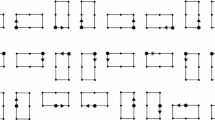Abstract
The purpose of this Note is to provide a deterministic implementation of the random wave model for the number of nodal domains in the context of the two-dimensional torus. The approach is based on recent work due to Nazarov and Sodin and arithmetical properties of lattice points on circles.
Similar content being viewed by others
References
J. Bourgain, On Pleijel’s nodal domain theorem, International Mathematics research Notices, to appear.
M. Berry, Statistics of nodal lines and points in chaotic quantum billiards: perimeter corrections, fluctuations, curvature, Journal of Physics. A. Mathematical and General 35 (2002), 3025–3038.
E. Bombieri and J. Bourgain, A problem on sums of two squares, International Mathematics Research Notices. IMRN, to appear.
E. Bogomolny and C. Schmit, Percolation model for nodal domains of chaotic wave functions, Physical Review Letters 88 (2002), 114102.
E. Bogomolny and C. Schmit, Random wave functions and percolation, Journal of Physics. A. Mathematical and General 40 (2007), 14033–14043.
J. Evertse, H. Schlickewei and W. Schmidt, Linear equations with variables which lie in a multiplicative group, Annals of Mathematics 155 (2002), 807–836.
P. Erdős and R. Hall, On the angular distribution of Gaussian integers with fixed norm, Discrete Mathematics 200 (1999), 87–94.
L. Fainsilber, P. Kurlberg and B. Wennberg, Lattice points on circles and discrete velocity models for the Baltzmann equation, SIAM Journal on Mathematical Analysis 37 (2006), 1903–1922.
A. Ghosh, A. Reznikov and P. Sarnak, Nodal domains of Maass forms, I, Geometric and Functional Analysis 23 (2013), 1515–1568.
M. Krishnapur, Continuing nodal domains in random plane waves, preprint, 2012.
H. Lewy, On the minimum number of domains in which the nodal lines of spherical harmonics divide the sphere, Communications in Partial Differential Equations 2 (1977), 1233–1244.
F. Nazarov and M. Sodin, On the number of nodal domains of random spherical harmonics, American Journal of Mathematics 131 (2009), 1337–1357.
M. Sodin, Lectures on random nodal portraits, http://www.math.tau.ac.il/~sodin/SPB-Lecture-Notes.pdf
A. Stern, Bemerkungen über asymptotisches Verhallen von Eigenwerken und Eigenfunktionen, Dissertation, Göttingen, 1925.
Author information
Authors and Affiliations
Corresponding author
Additional information
This work was partially supported by NSF grants DMS-0808042 and DMS-0835373
Rights and permissions
About this article
Cite this article
Bourgain, J. On toral eigenfunctions and the random wave model. Isr. J. Math. 201, 611–630 (2014). https://doi.org/10.1007/s11856-014-1037-z
Received:
Revised:
Published:
Issue Date:
DOI: https://doi.org/10.1007/s11856-014-1037-z



